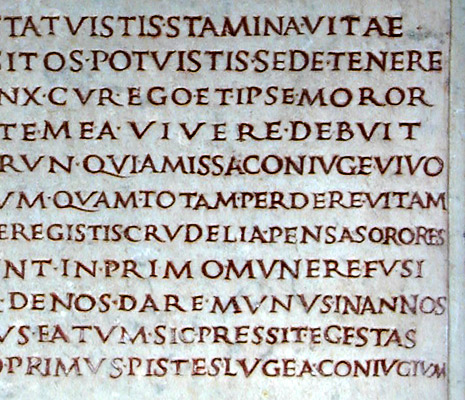Claudia Piste Inscription: Meter
After the formulaic heading, the epitaph becomes a verse eulogy in
dactylic hexameter (see description in
Reading Latin Poetry). This meter was considered appropriate
for “high” literature, such as epic poetry; thus in Rome it was
associated with the aristocratic classes. Primus must have chosen the meter for
its associations with both serious themes and social status. For a good example
of how a Roman poet played with the heroic significance of dactylic hexameter,
see the opening lines of Ovid's Amores 1.1 in
Intermediate Latin
Readings, particularly the
discussion of the meter.
Inscriptional poems often combine verses of different lengths and do
not always subscribe to the conventions of formal Latin poetry. Most of the
lines of Primus's poem will scan as dactylic hexameter, but there are some
exceptions:
- Line 3 is a line of dactylic pentameter—two and a half metric
feet followed by a strong pause or caesura that coincides with the end
of a word, followed by two and a half feet (see an illustration of this meter
in the elegiac
couplet). The strong metrical break in the middle of the line emphasizes
its meaning—the death of his wife has broken up this “so
well-matched” couple.
- Line 4 will scan only if one treats the ui in debuit
as a diphthong, which may be how it was pronounced
- line5 will scan only if one shortens the long e in
contigerunt, a practice found in poetry
- Line 9 requires that the e in denos be scanned as
short.
Two additional metrical anomalies are very meaningful and allow us to
hear the poet's grief:
1. Line 7 opens like a pentameter, with two and a
half feet followed by a caesura; what follows is a full six feet of
dactylic hexameter. In this way Primus dramatically emphasizes the words nec
vitae nasci, pointing up the tragedy of losing his wife with no new life to
compensate:

2. In line 11, the poet adds two feet in the middle of a pentameter
line, enclosing his name and that of his wife between two caesurae,
vividly calling attention to their union even after her death:

The detail below of the right side of the stone shows the difficulties
that Primus's poem created for the stonecutter: his lengthy poetic expression
apparently caused the stonecutter to decrease the height of the letters in
order to fit the lines in the space. He also had to crowd together letters at
the ends of lines, particularly in lines 7 and 11. This view also reveals what
epigraphers call “interpuncts,” the dots or points frequently used to
separate words in inscriptions, which here are also used to separate syllables
within words longer than two syllables. The blank space below the text may have
been a result of the decreased height of the letters toward the end of the poem
or it may have been intentionally left open for the inscription of a brief
epitaph for Primus upon his death.

Ann R. Raia and
Judith Lynn Sebesta
Return to
Claudia Piste Inscription
March
2006


